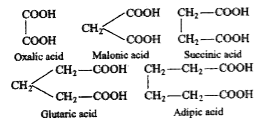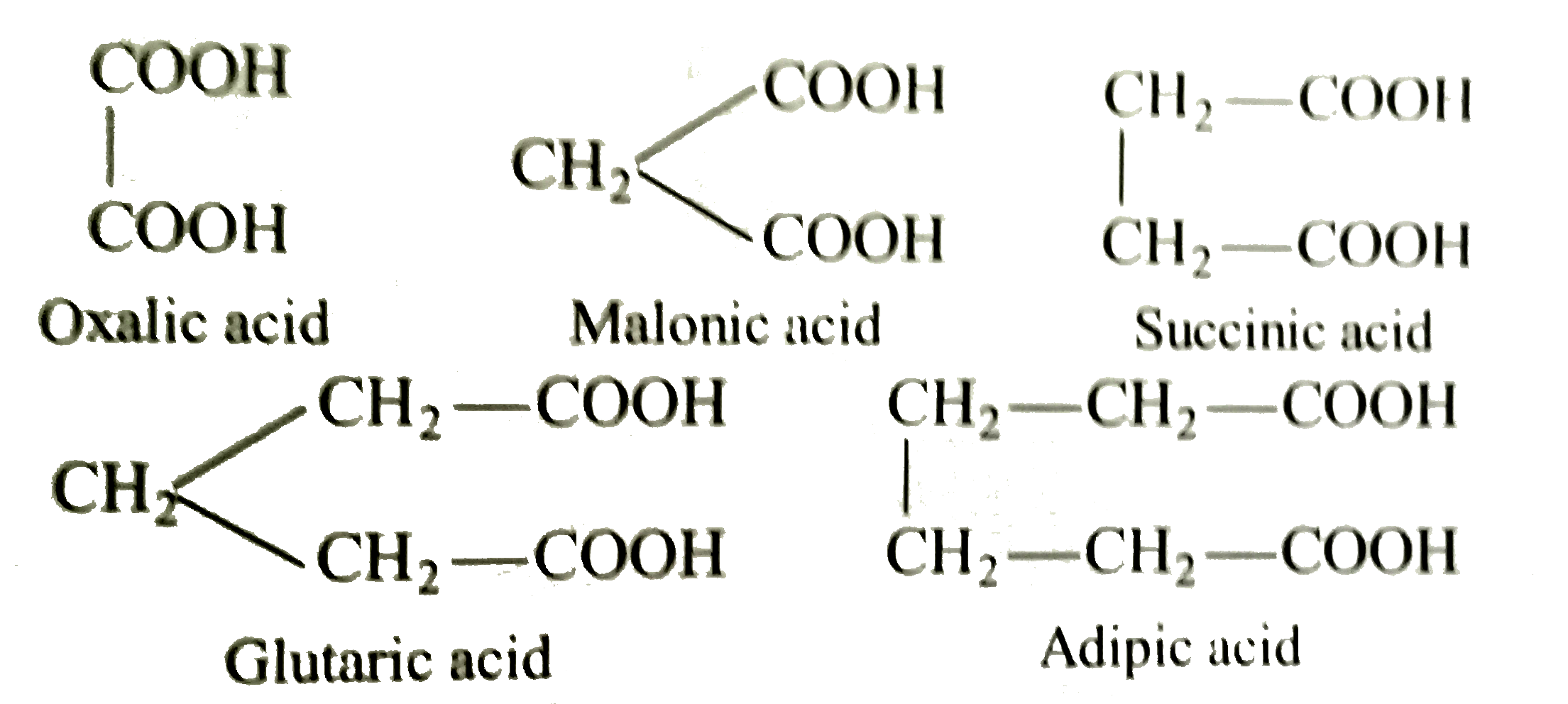Paragraph
Dicarboxylic acids have two carboxylic groups, eg.,

Acidity of dicarboxylic acid depends upon the stability of intermediate ion and upon the distance between two carboxylic groups. Shorter the distance between two carboxylic groups, greater is the acidic character. Melting point of these acids depends on the symmetry. Greater the symmetry, higher will be the melting point.
Dicarboxylic acids on heating give monocarboxylic acid, alkanes, cyclic ketones depending on the conditions
Which of the following dicarboxylic acids is used in the manufacture of nylon-66? Solution in Malayalam
Succinic acid
Glutaric acid
Adipic acid
Oxalic acid
The correct Answer is:C
Adipic acid
Topper's Solved these Questions
- BOOK - BRILLIANT PUBLICATIONCHAPTER - CARBOXYLIC ACID & THEIR DERIVATIVESEXERCISE - LEVEL-III (Statement Type Questions)6videos
CARBOXYLIC ACID & THEIR DERIVATIVES
- BOOK - BRILLIANT PUBLICATIONCHAPTER - BIOMOLECULES, POLYMERS AND CHEMISTRY IN EVERYDAY LIFE EXERCISE - LEVEL-II (ASSERTION-REASON TYPE QUESTIONS)6videos
BIOMOLECULES, POLYMERS AND CHEMISTRY IN EVERYDAY LIFE
- BOOK - BRILLIANT PUBLICATIONCHAPTER - CARBOXYLIC ACIDSEXERCISE - LEVEL-II (Assertion -Reason)4videos
CARBOXYLIC ACIDS
Similar Questions
Statement 1 : The melting points and boiling points of aliphatic acids are usually higher than those of aromatic acids of comparable molecular masses.
Statement 2 : The planar benzenering in the aromatic acids can fit more closely in the crystal lattice than zig-zig structure of aliphatic acids.02:09View SolutionAssertion : Glucose gives a reddish brown precipitate with Fehling's solution.
Reason : Reaction of glucose with Fehling's solution gives CuO and gluconic acid.01:37View SolutionAssertion : p-chlorobenzoic acid is more acidic than p-fluorobenzoic acid.
Reason : +R effect of fluorine is higher than that of chlorine due to the matching size of carbon and fluorine.01:07View SolutionDicarboxylic acids have carboxylic groups e.g.
HOOC-COOH,oxalic acid
HOOC−CH2−COOH-Maloic acid
HOOC-(CH2)3-COOH-Glutaric acid
HOOC,(CH2)4-COOH,-Adipic acid
Acidity of dicarboxylic acids depends upon the stabillity of intermediate ion and upon the distance between two carboxylic groups. shorter the distance between two carboxylic groups, greater is the acididc character. Melting point of the acids depends on the symmetry. greater the symmetry, higher will be the mp. Dicarboxylic acids on heating give monocarboxylic acid, alkanes, cyclic ketones dependings on the conditions.
Which of the following is the most acidic ?View SolutionDicarboxylic acids have carboxylic groups e.g.
HOOC-COOH,oxalic acid
HOOC−CH2−COOH-Maloic acid
HOOC-(CH2)3-COOH-Glutaric acid
HOOC,(CH2)4-COOH,-Adipic acid
Acidity of dicarboxylic acids depends upon the stabillity of intermediate ion and upon the distance between two carboxylic groups. shorter the distance between two carboxylic groups, greater is the acididc character. Melting point of the acids depends on the symmetry. greater the symmetry, higher will be the mp. Dicarboxylic acids on heating give monocarboxylic acid, alkanes, cyclic ketones dependings on the conditions.
Which of the following dicarboxylic acid is used in the manufactures of nylon-6,6?04:34View SolutionDicarboxylic acids have carboxylic groups e.g.
HOOC-COOH,oxalic acid
HOOC−CH2−COOH-Maloic acid
HOOC-(CH2)3-COOH-Glutaric acid
HOOC,(CH2)4-COOH,-Adipic acid
Acidity of dicarboxylic acids depends upon the stabillity of intermediate ion and upon the distance between two carboxylic groups. shorter the distance between two carboxylic groups, greater is the acididc character. Melting point of the acids depends on the symmetry. greater the symmetry, higher will be the mp. Dicarboxylic acids on heating give monocarboxylic acid, alkanes, cyclic ketones dependings on the conditions.
Sodium adipate on electrolysis gives :03:04View SolutionDicarboxylic acids have two carboxylic groups, e.g.,

Acidity of dicarboxylic acid depends upon the stability of intermediate ion and upon the distance between two carboxylic groups. Shorter the distance between two carboxylic groups, greater is the acidic character. Melting point of these acids depends on the symmetry. Greater the symmetry, higher will be the melting point.
Dicarboxylic acids on heating give monocarboxylic acid allkanes, cyclic ketones depending on the conditions
Which of the following has highest melting point?View SolutionDicarboxylic acids have two carboxylic groups, e.g., Acidity of dicarboxylic acid depends upon the stability of intermediate ion and upon the distance between two carboxylic groups. Shorter the distance between two carboxylic groups, greater is the acidic character. Melting point of these acids depends on the symmetry. Greater the symmetry, higher will be the melting point. Dicarboxylic acids on heating give monocarboxylic acid allkanes, cyclic ketones depending on the conditions Which of the following dicarboxylic acids, will give monocarboxylic acid on heating ?
01:56View SolutionAmino acids are classified as acidic, basic or neutral depending upon the relative number of amino and carboxyl groups in their molecule. Which of the following are acidic-
02:26View SolutionAmino acids are classified as acidic, basic or neutral depending upon the relative number of amino and carboxyl groups in their molecule. Which of the following are acidic ?
01:56View SolutionAttachment of vinyl group or phenyl group directly to carboxylic acid group has effect on the acidic character of that carboxylic acid. Explain.
03:23View SolutionAmino acids are classified as acidic, basic or neutral depending upon the relative number of amino and carboxyl groups in their molecule. Which of the following are acidic?
03:23View SolutionAttachment of vinyl group or phenyl group directly to carboxylic acid group has effect on the acidic character of that carboxylic acid. Explain.
48:14View SolutionThe boiling and melting points of carboxylic acids depend on :
41:45View SolutionThe boiling and melting points of carboxylic acids depend on :
36:23View SolutionDicarboxylic Acid, hydroxy Carboxylic Acid, Amino Acid, Calcium Salt OF Carboxylic Acids and Examples
02:21View Solution

